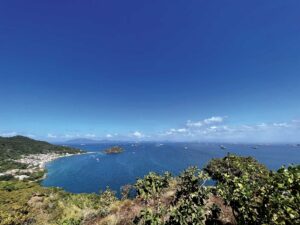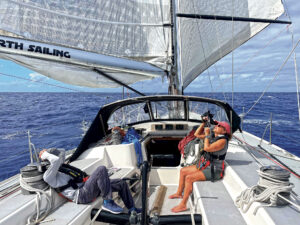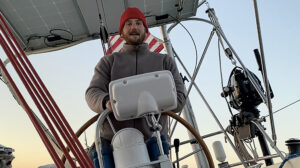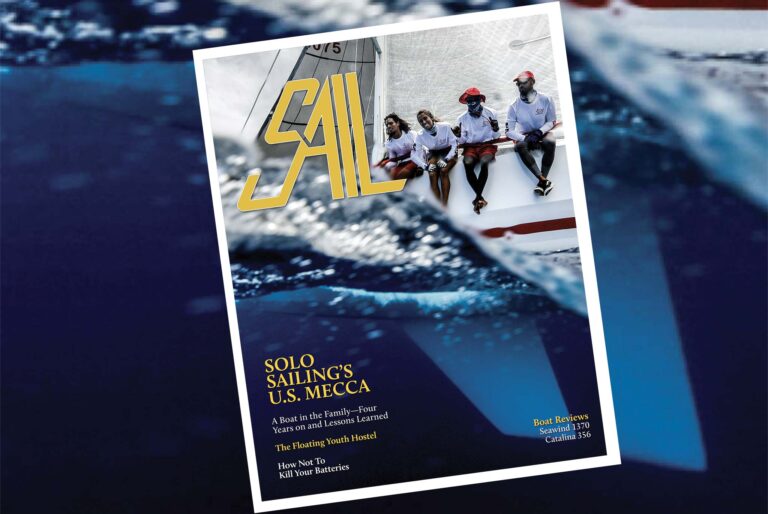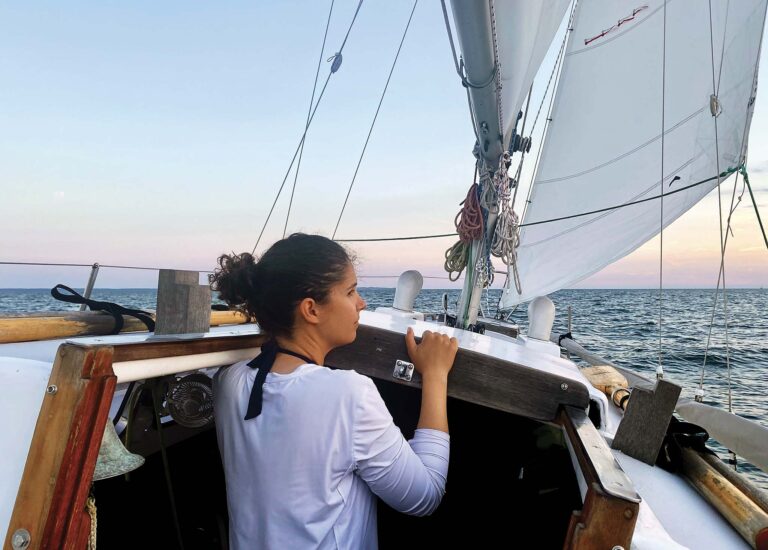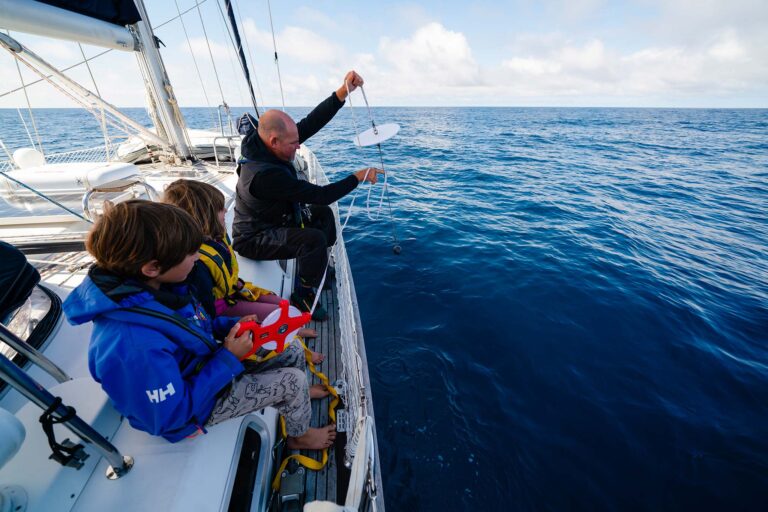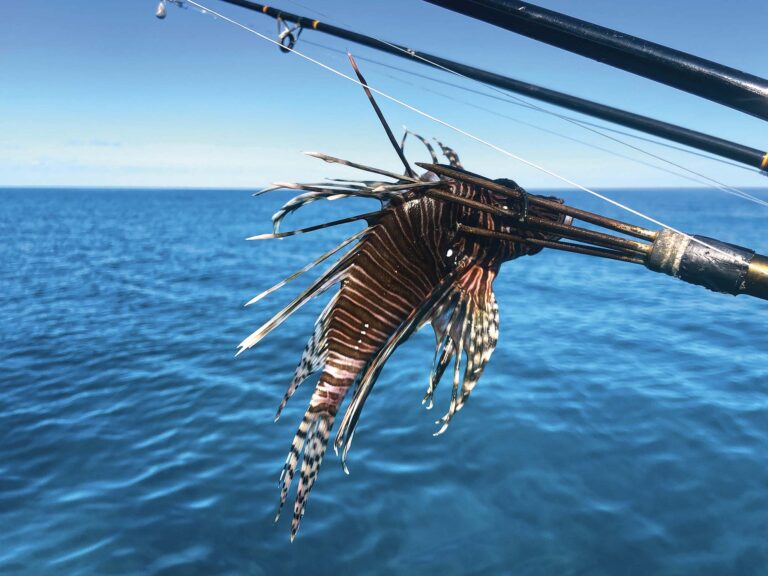Most people have no idea what it’s like to be out on the ocean away from their comfortable lifestyle here in the United States. Back in the early 1970s, though, my wife, Kitty, and I spent four years circumnavigating the globe on our 30ft Allied Seawind ketch, Bebinka.

Before we left, friends would ask, “You are going to sail across oceans in a 30ft boat! Aren’t you afraid of storms?” But we’d never been much afraid of storms, because on our home waters of Long Island Sound whenever the wind started to blow, we would simply heave-to and ride out the bad weather. Then came the day of July 14, 1974, midway between Cape Hatteras and Bermuda and only 500 miles from completing the voyage, when we were caught in a fearsome storm and finally understood why others were always so concerned about such things.
When the wind started to come up, we hove-to. But a few hours later, as the wind continued to build, the roar became deafening as the wind-speed indicator pegged out at 70 knots, and we took all sails down and lay ahull. We became lulled by the apparent calm with which Bebinka was riding out the storm, heeling over with the wind. But that changed in the middle of the night, when we fell off the top of a wave and hit the trough upside down with such force that the main hatch blew right off, as did the teak grab rails on the cabintop, our spray dodger and our self-steering windvane.
At the time, Kitty and I had been down below, and as Bebinka fell over, we both rolled onto the cabintop. As we righted, the now open hatch scooped up so much water it came up to the level of the bunks in the saloon. Looking out I also saw the liferaft was still in the cockpit, meaning we still had a safety net. I thanked the Lord it was there because had it been on deck, it would have been blown off with the rest of the stuff.

The next morning when things calmed down, we reviewed the damage. Seeing that everything had been blown off the cabintop and that even the main boom had broken in two, we couldn’t believe we had survived. We thankfully saw that the mast was still standing, no doubt because in New Zealand we had re-rigged with galvanized steel two sizes bigger than what we’d had previously. We’d also taken both the jibs below and furled and tied the main and mizzen sails to the boom. After cleaning up the mess below, I tried to fix the broken boom by putting in a four-by-four and bolting the parts together, which worked well enough that we were able to set some sail and limp our way home. Approaching New York City, I was finally able to hand-crank the 18hp diesel engine and get it started, which enabled us to power up the East River and through the narrow tidal strait of Hell Gate.
Following our return to Westport, Connecticut, we spent the summer fixing all the damage. Lessons learned included: 1) don’t keep the liferaft on deck, and 2) when crossing oceans, always have a parachute anchor and a set of drogues to keep the boat stern-to the seas in nasty storms. Still, rather than becoming fearful of ever again going to sea, we got back up on the horse that fall and set sail for St. Thomas in the Virgin Islands to take a couple of jobs that had been offered to us there.
A year after that we decided it was time to go back to Connecticut, get “real” jobs, buy a house and start a family. However, we’d loved our time on the sea so much we always had it in our minds to do it again sometime. Even after we started a family, the desire to go sailing never left us and was reinforced by wanting to show our kids, Spencer and Alex, that there was more to the world than Fairfield County.
In 1982, we were fortunate to buy Tamure, a Valiant 40, from an old friend who was moving up to a bigger boat. Then in 1987, when our two boys were 9 and 11, we felt it was time to cast off lines again and head out on the next adventure of a lifetime, packing the boys and a couple of tons of gear onto Tamure and sailing off for another four-year voyage.

On our first trip, we had sailed from northwest Australia across the Indian Ocean and down under South Africa. On this trip, though, we wanted to go somewhere new. When we told friends that our plan was to go up the Red Sea, they immediately asked, “Aren’t you afraid of pirates?” Once again, we shrugged it off. However, when we got back home in 1991, we again had a “scary” story to tell.
In New Zealand, we’d decided to sail to New Caledonia, the Solomon Islands and then New Guinea. From there, we continued on to Bali in Indonesia, where we spent a couple of weeks before heading up the Java Sea to Singapore, Malaysia and Thailand, after which we’d sail up the Red Sea to the Mediterranean.
We left Bali in company with two other boats—fellow Cruising Club of America members Bob and Beth Lux on Rhodora, a Bermuda 40 yawl, and Carl and Peri McIlroy on KuKara, a 40ft Cheoy Lee—and the first night out anchored off the island of Bawean in what I had considered to be a truly remote area. Indonesia, however, is very densely populated, and after we were securely anchored, a local fishing boat with about 10 men on board also dropped anchor a hundred yards away. Painted in psychedelic designs, it looked like a seagoing version of Tom Wolfe’s bus in his 1968 book, The Electric Kool-Aid Acid Test, and once anchored, the crew all hung over the side staring at us, as if sizing us up. However, they made no move to approach, and by late that evening I decided that if they’d had any nefarious intentions, they would have already acted, so I went to sleep.
The next day we all headed up the Java Sea, bound for Singapore. But as we approached the southern end of Borneo, Bob came on the radio and said that he and Beth had decided they were going to divert to Borneo. “After all,” he said, “I will never be by this place again and I would love to see it!”
A short while after that we saw a freighter coming toward us and hailed it on the radio to make sure that they saw us and would alter course, as we were under spinnaker at the time. After acknowledging our presence and agreeing to stay clear, the captain asked us where we were headed. When I told him Singapore, he came back on the radio and ruined our day! “Listen,” he said. “From here on in be very careful. In the last month, two of our ships were boarded by guys with automatic weapons and the crew held up at gunpoint. There is still piracy in the area, so be careful.” This, of course, was something we had most definitely not wanted to hear.
To make matter worse, that night we encountered a violent thunderstorm and had to dodge numerous thunderheads, so that the next day we were exhausted. We therefore decided to anchor off Pulau Karimata, what appeared on the chart to be a little deserted island southwest of Borneo, where after a short rest and peanut butter sandwiches for lunch, Kitty and the boys broke out the schoolbooks and started doing their lessons for the day belowdecks. Meanwhile, I stayed on deck to take care of a few of the never-ending boat chores.
A few minutes later, I looked up and saw a fishing boat not too far away. I didn’t think anything of it, until I looked up again and saw that it was coming right at us. There was a man on the foredeck wearing dark clothes and a ski mask, and another ski mask was peeking up out of the hold. Just as the boat was about to hit us, the guy at the tiller slammed the engine into reverse, and before I could react, the guy on the foredeck had jumped aboard to tie his boat to ours, and there were three dangerous-looking men in ski masks on Tamure.

Immediately, I began yelling at them in English to get off our boat, prompting them to yell back at me in Indonesian. Of course, they didn’t understand a word I was saying, and I didn’t understand them. Our oldest son, Alex, stuck his head up through the companionway hatch to see what was going on, and I yelled at him as well to get down below. Two minutes later, though, as we were all still frantically yelling, Kitty stuck her head out the hatch as well and handed out three Cokes and a pack of cigarettes. Suddenly, the men whipped off their ski masks and all broke into big smiles.
After that, we all sat down together in the cockpit and started communicating using sign language. I brought out the chart I’d been using and asked them where they were from. They pointed at the chart and chatted away with one another as if this was the first time they had seen an actual chart of their fishing grounds. One of the men poked at the chart, looked at me and held up two fingers. which I took it to mean, did I have two charts? I did and gave them that one. With big smiles, they looked at me as if we were their new best friends.
All the while Kitty kept looking out the companionway until an hour or so later when she started to wonder how we could ask them to leave. Finally, they brought me over to their boat, where they loaded my arms with fish until I had to point out I couldn’t hold anymore and thanked them. I then climbed back onto Tamure, and they started their engine. As they drove off, they each made a fist and wagged a thumbs-up. Afterward, a version of the Coca Cola jingle kept playing in my head: “I’d like to buy the world a Coke…and live in harmony!”

Years later when we were in the Bahamas, we invited another cruising couple to come on board for an afternoon sundowner. As we were telling them our story about being boarded by “pirates,” one of our guests told us that she was from that part of Borneo and explained that fishermen and construction workers typically wear ski masks despite the heat in order to protect their faces from the sun. (Apparently, in Borneo, the lighter your skin, the higher your social standing.) She also told us there is no such thing as private property in the way we understand it. People just walk into someone’s home and say hello.
I wish we had known all that before we sailed there! Nonetheless, I think everything worked out well in the end—yet another example of why we love sailing to far horizons to make friends in different parts of the world and learn about their cultures.
Ed Note: In addition to their two circumnavigations Kitty and Scott Kuhner sailed from the Bahamas to Portugal via Bermuda and the Azores in 2003 and then sailed back across the Atlantic by way of the Canaries. They have since cruised extensively along the U.S. East Coast and throughout the Bahamas. In 2017, the Kuhners, both long-time members of the Cruising Club of America (CCA) received the CCA’s Far Horizons Award for “a meritorious cruise or series of cruises which exemplify the objectives of the club.” The CCA is North America’s premier offshore cruising and racing organization. It is comprised of more than 1,300 ocean sailors, has 14 stations around the United States, Canada and Bermuda, and together with the Royal Bermuda Yacht Club organizes the biennial Newport Bermuda Race.
March 2020

